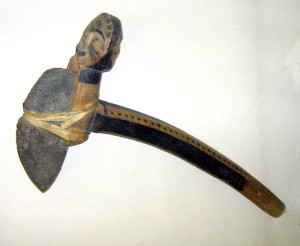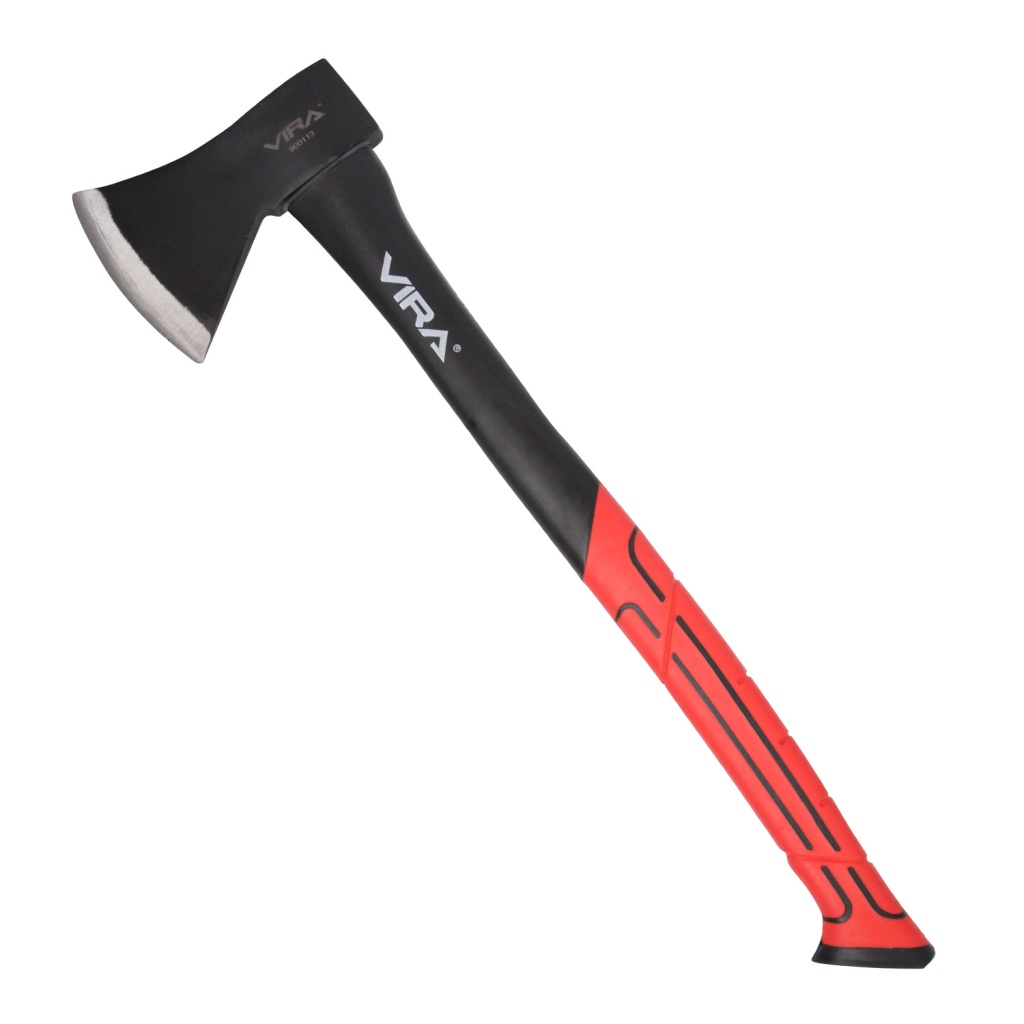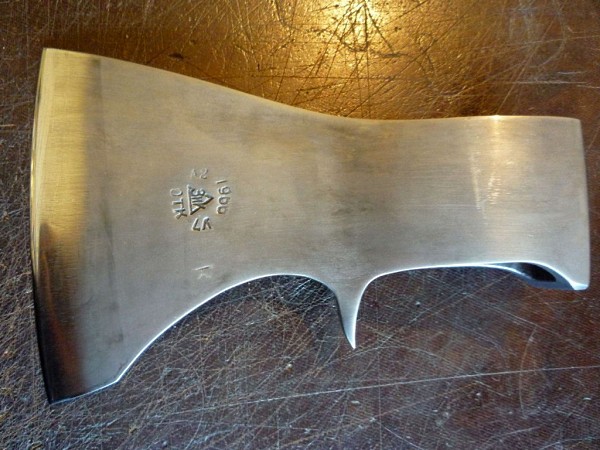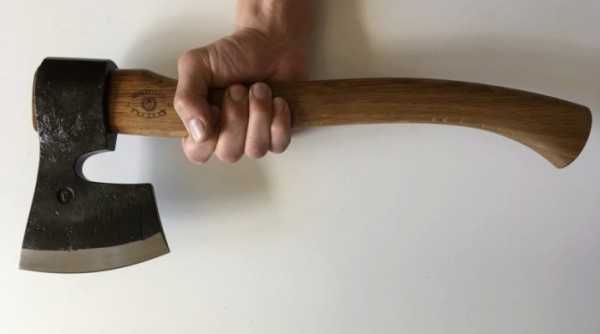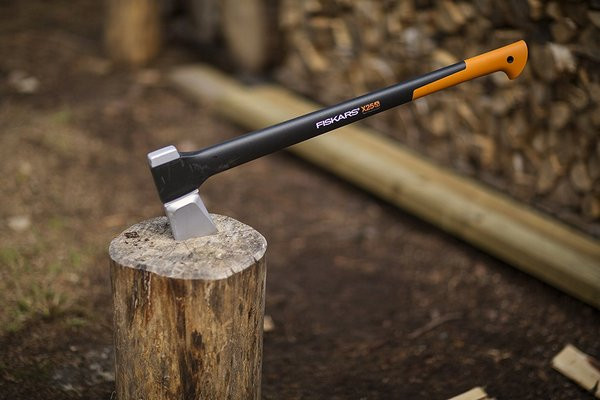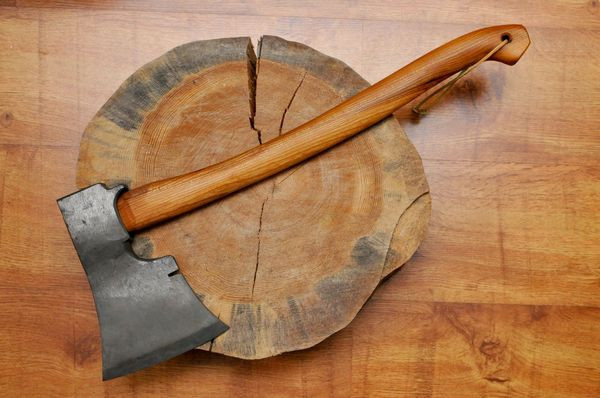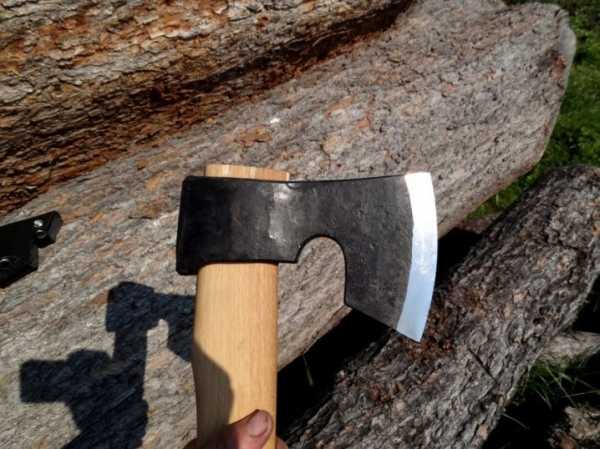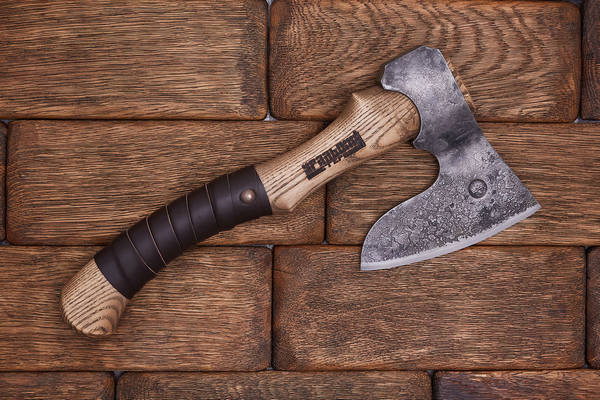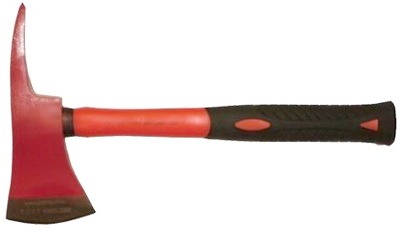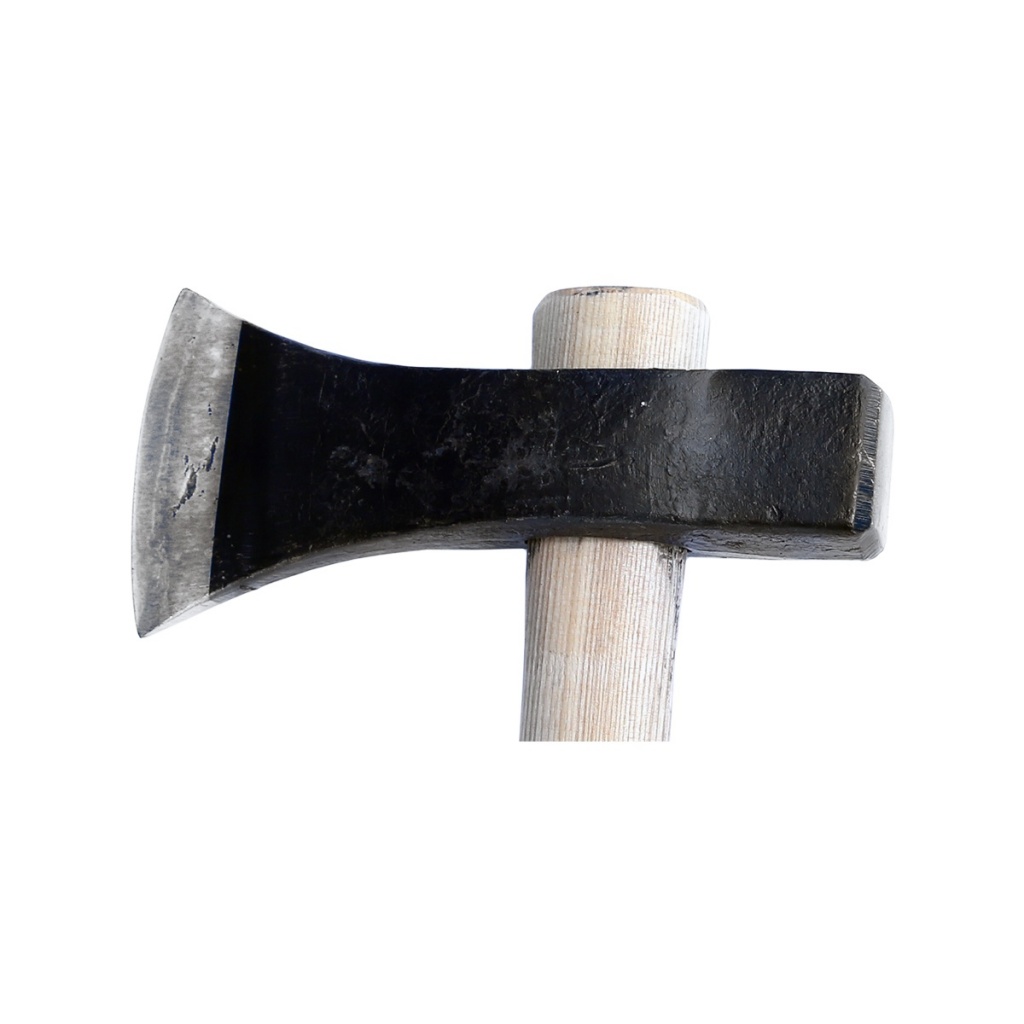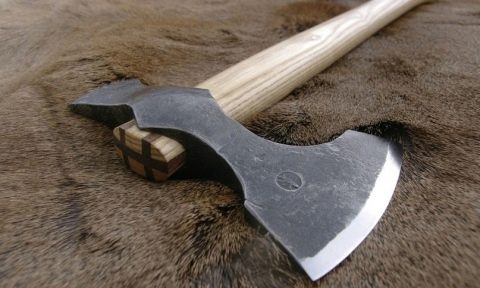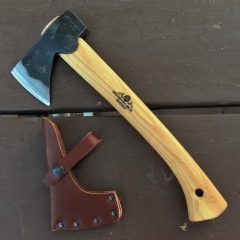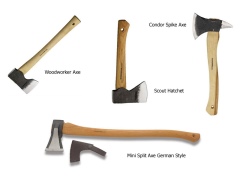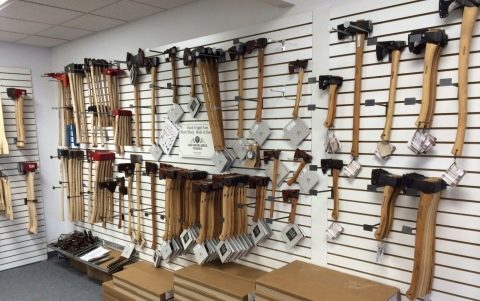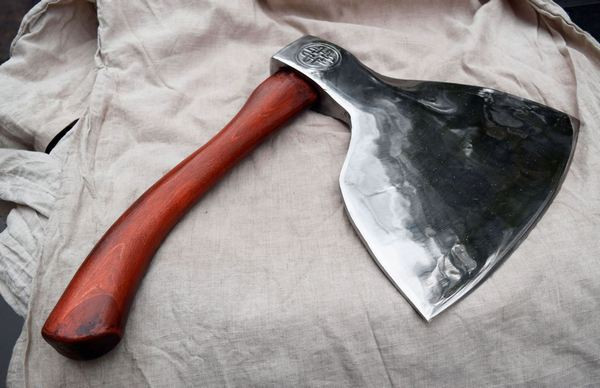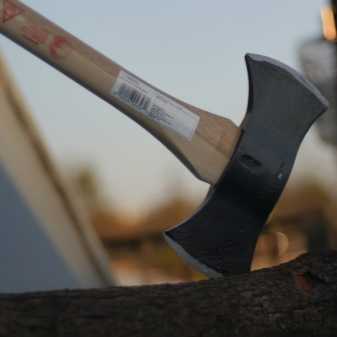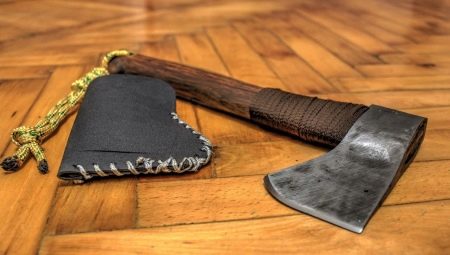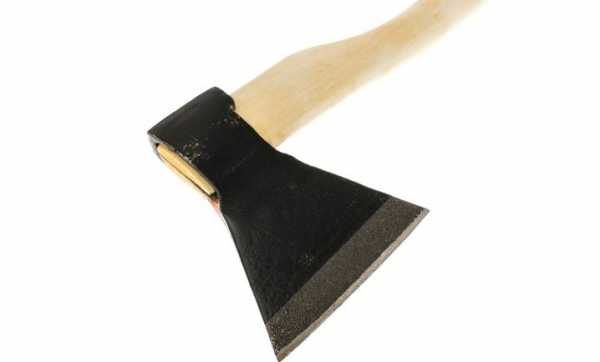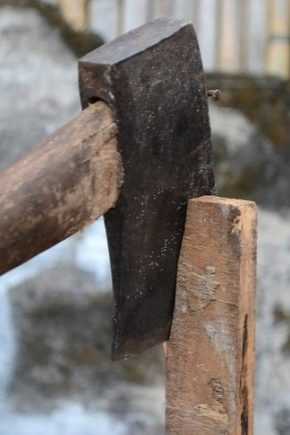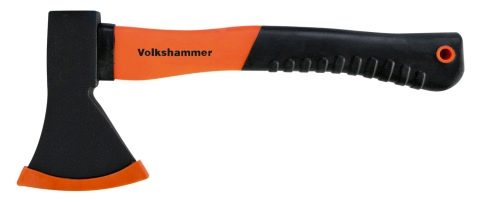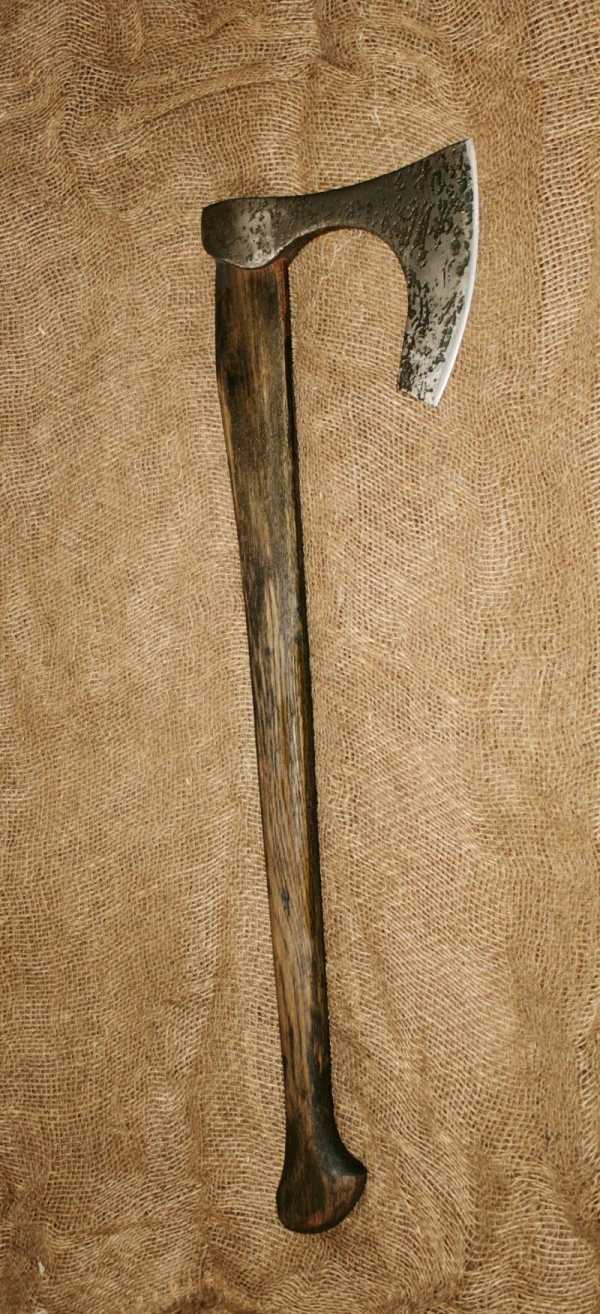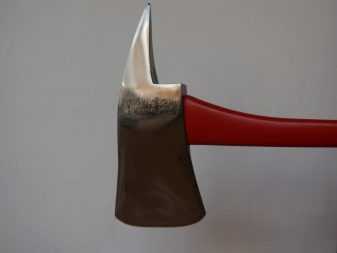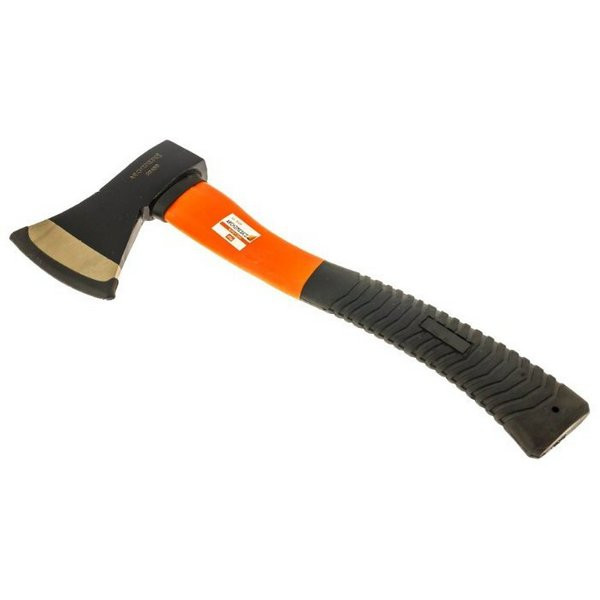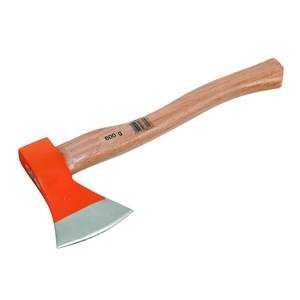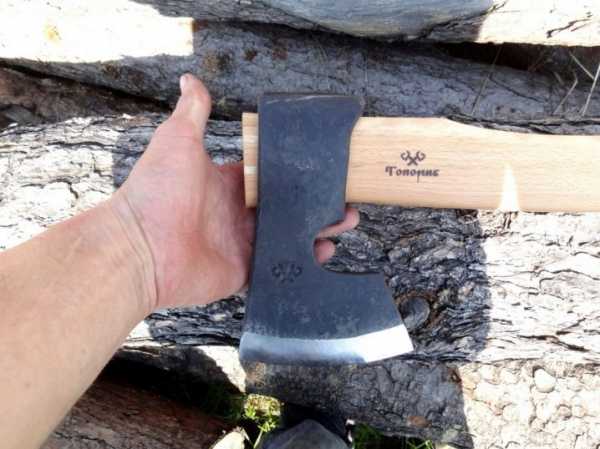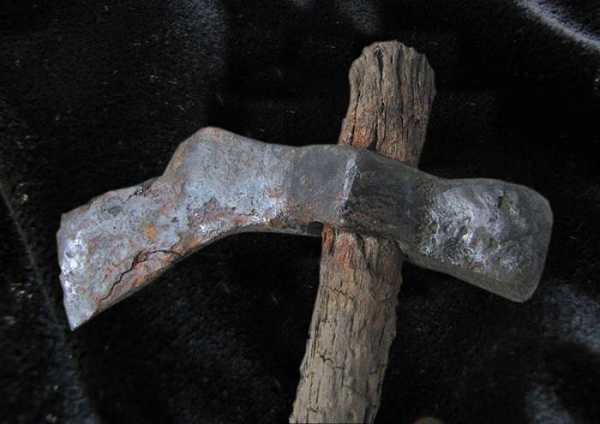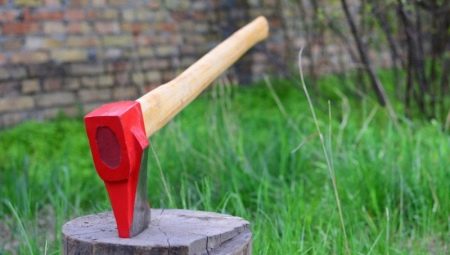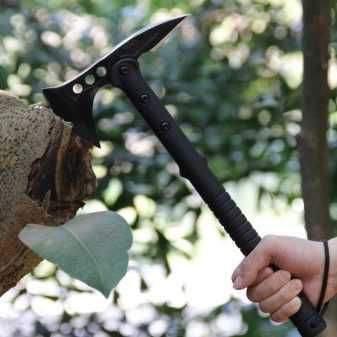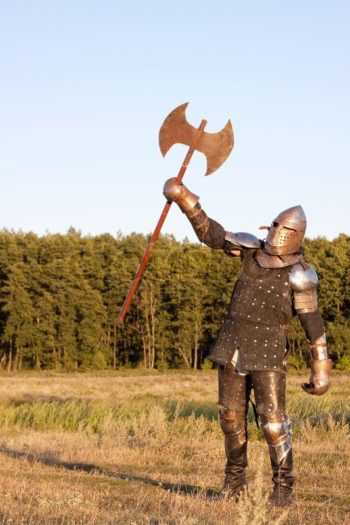What is different from the usual?
For example, from taiga carpentry axes differ blade shape and handle length. The tasks that the tools must perform are the opposite. With a carpenter's ax, you need to cut it as accurately as possible. The workers here are not in a hurry, since the main thing in the course of such work is not to make mistakes.
Fishing products or cleavers perform a different function - they cut wood quickly and deeply. The shape of the ax is made in such a way that it is faster to knock down a tree than with a carpenter's tool with equal effort.
Carpentry options do not have a powerful groove - a protrusion under the ax handle, which prevents the handle from breaking when vibrated. This projection absorbs about 50% of the load. However, this groove will not save the handle if it breaks against the chock. The carpenter's ax is not equipped with a wide front part. The blade of the fishing option is made at an angle. This allows the worker to use the tool like a cleaver. You just need to concentrate energy on the right blow.
The handles of carpentry and fishing tools differ in the angle of inclination. The first option has a smooth downward angle. The protruding edge of the ax is visible visually. The fishing tool simply does not have it. This very corner creates strong vibrations.
In addition to the blade, the carpentry version also differs in the hatchet. It has an ovoid cross-section here. The first half of the carpentry tool should not be very heavy and thin, otherwise it will quickly break. Aspen handles are considered to be of high quality. A good piece should be strong and lightweight. Homemade options are recommended to be processed not with varnish, but with drying oil. The lacquered ones will slip and turn out to be cold.
Ax cleaver
This type of ax is designed for one purpose - splitting logs or trunks when chopping wood. The cleaver has a peculiar shape of a metal blade. In appearance, it resembles a drop from the end. That is, the blade of this ax expands very sharply to the point where the hatchet is inserted into the metal part. This is done so that in the process of splitting firewood, the blade works in the form of a wedge, pushing the wood fibers to the side, splitting the stump.
The cleaver is usually quite heavy, since the impact on the wood is carried out not due to a sharp blow, but due to the inertia force. To split the tree, it is enough to sharply lower the cleaver on the stump, which, taking into account the mass of the ax, will split it quite easily. Cleavers usually have a long handle in order to increase the force of the blow. The handle of the cleaver is usually made of hard and viscous types of wood: birch, maple, elm.
It is not recommended to use oak as a material for an ax. Due to the increased strength during operation, such a hatchet will "dry hands". That is, most of the energy from the impact will be transferred to your hands, due to which you will quickly get tired. If you are cutting stumps with a lot of knots, along with the cleaver, you may also need wooden wedges to hammer into the tree until it splits.
When choosing this tool in a store, we do not advise you to "lead" to shiny, chrome-plated models with a plastic ax. A good old cleaver with a wooden hatchet and a forged metal part is better suited for chopping firewood, moreover, it is much cheaper.
The main types of axes
There are many different axes, but many of them have not been used for a long time.
Among the most famous are the following:
• Cleaver - a massive tool designed for splitting firewood.
It has a lot of weight (about 3 kg, sometimes there are 5-kilogram versions).
They work with both hands, because the handle is made large and long.
• For felling trees the largest ax is used.
Its handle is 90 cm long and weighs no more than 3 kg.
• For chopping meat a tool with a wide blade and a short handle will do.
With such a weapon, it is easy to deliver accurate strikes.
• Plotnitsky the tool is sharpened to a razor sharpness.
This is a light tool that is used on the construction site for the construction of log cabins.
• Ax-hoe - an agricultural tool that resembles a hoe.
• Fire axe All-metal on the handle has rubber pads to prevent burns.
It is used by rescuers and firefighters when carrying out measures to extinguish fires.
• Ice ax - an ax is a special tool for breaking and chopping ice.
• Army or sapper ax - small in shape and light in weight, has a transport cover.
It can be performed in different ways in different armies of the world.
• Roofing one-handed ax - a special tool that builders use when arranging a roof.
On one side is a narrow sharpened blade, on the other is a hammer.
The tool helps you hammer in nails or cut down the battens.
• Throwing refers to military, hunting or sporting weapons.
It is often used as an interior decoration.
• Ax-pickaxe helps to process stone or extract precious minerals.
• Teslo used by builders in the construction of a log house.
It has an unusual shape and is used to cut a groove in wood.
• Tourist - a small ax - resembles an army one, but less in weight, it has a universal purpose.
Covers are used for carrying.
• Kitchen - food preparation assistant.
Made of stainless steel.
It will help to chop up bones and, if necessary, beat off meat.
• Ax-sledgehammer allows it to be used for splitting large logs.
The butt can serve as a sledgehammer.
• Beard Ax used in the old days as a type of weapon.
In the modern world, it is more often used as an interior decoration.
• Russian ax.
Its purpose has two directions: combat and woodworking.
To date, a large number of varieties of axes are presented in stores.
You need to choose them depending on the purpose of the application.
Economic
This type of inventory has a universal purpose.
It is used in the household for chopping wood, chopping wood, for carpentry work, and so on.
The blade is made of high quality steel, which is not afraid of hard elements.
The cost of such a tool is low.
It is simply impossible to do without it on the farm.
Carpenter's ax
Sharpen these tools at a 35 degree angle, otherwise the blade will get stuck in the wood.
The carpenter's ax has a rounded blade and a handle length of about 40 cm.
Weight is also an important parameter, which is about 1.5 kg.
Cleaver - ax for firewood
A feature of this weapon is that its piercing part does not have a sharp edge, but has an impressive weight of about 2-3 kg.
The hatchet should be long - 80-90 cm.
The splitting ax will easily split a log or log.
They work with both hands.
Rule 2: pay attention to the hatchet
First you need to decide which material is preferable. Traditionally, the tool's handle was made of wood, and today it is this material that is the most popular. Most often, birch, oak, ash and other dense species are used, from which an elastic handle is obtained that can absorb a blow.
When choosing an ax with a wooden hatchet, you need to pay attention to the direction of the location of the fibers - they should go along. The array must be free from defects, for example, traces of knots or cracks
This ensures that the handle will withstand heavy impacts and will not crack. The only drawback of such axes is that the handle may darken from damp or dry out over time. Therefore, if you choose an ax for work in such conditions, it is better to give preference to a model with a handle treated with paint or varnish.
Also on the market for hand tools are metal axes. As a rule, the handle with the blade has an all-metal construction, so these products are very reliable. For a comfortable grip, the handle is supplemented with a rubberized pad that prevents the hand from slipping during operation. But such tools are slightly heavier than those with a wooden handle.
In terms of practical benefits, the use of fiberglass for the manufacture of percussion tools significantly increases the performance of products. With a strong impact, such a handle will not only withstand a large mechanical load, but also reduce the impact of vibration on the user's hands. To prevent the hand from slipping, the handle may have a solid rubber pad or several grooved rubber inserts.
When choosing an ax pay attention also to handle length. For tourist hatchets, it is short - about 20 cm, which lightens the weight and makes the tool compact
It doesn't take up much space in your backpack and can also be hung on your belt. In the case of tree felling or firewood chopping attachments, the length of the ax is from 35 to 50 cm. This provides a good swing and allows you to strike with great force.
Master's advice: optimal length of the ax is one that is 6-7 times the width of the butt. This ratio guarantees the convenience of the swing, as well as the fact that the design of the tool will withstand strong impacts.
In addition to strength and reliability, the handle should also be comfortable. It depends on its shape. Most instruments have a bend in the handle to provide a secure grip.
Make sure that the handle is not too bent, otherwise this place will be most vulnerable to impact, and the ax may crack
The end of the handle is usually slightly widened to prevent the tool from falling out of the hand if accidentally slipped. An additional guarantee that the ax does not fall out is provided by the presence of a hole in the handle for threading the string. By locking your wrist in the loop, you will be more confident that while working, the risk of injury is minimal.
How to sharpen an ax correctly
It is important for comfortable handling that the product is sharp. The sharpening procedure should be carried out regularly, since over time the tool becomes dull
The sharpening procedure should be carried out regularly, since over time the tool becomes dull.
This can be done with a power tool or by hand using a sharpening block that provides greater sharpness.
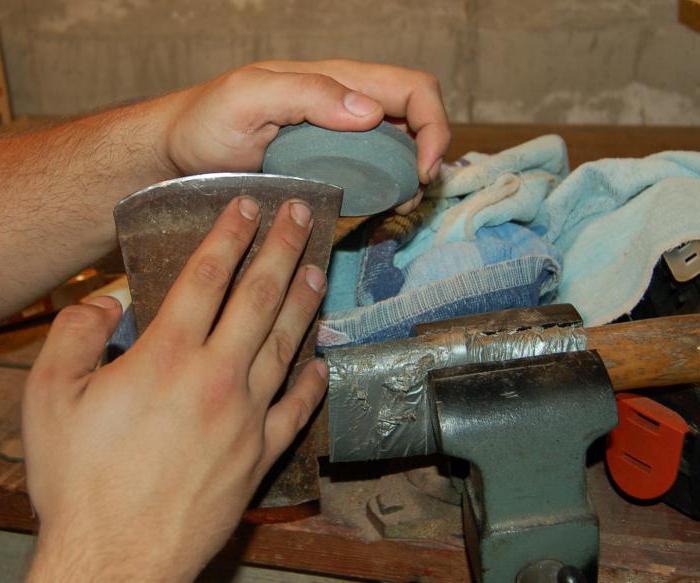
However, there are types of tools that must remain blunt.
This applies to the cleaver and fire ax, otherwise it will get stuck in the wood.
Therefore, in order to understand how to sharpen an ax, you need to determine what type of product is used.
Choosing the right angle for sharpening is also important.
It is most often 20-30 degrees.
If a sharp blade is needed, then a 35-degree angle is chosen.
When sharpening, avoid overheating, otherwise the steel will soften and wear out quickly.
Errors during work are most often made not only due to the lack of the necessary skill, but also in a hurry.
When using a power tool, there is a high risk of overheating the metal, which changes its properties.
For an electric grinder, you need to set the minimum speed and choose the most even circle.

The blade is held against the rotation of the circle, and in order to avoid overheating, it is periodically lowered into the water.
Professional advice
Here are some simple tips for sharpening your tool:
• do not use a grinder for sharpening: it has high speed, which will lead to overheating of the steel; • work slowly, in a calm rhythm; • use water for cooling; • set the power tool to low speed; • proper storage helps to keep the blade sharpened longer: it is better to put the product in a cover made of thick fabric or leather; • to protect against corrosion, coat the metal part with oil and wax; • wear safety glasses and gloves to protect yourself during work; • a double-sided product is sharpened sharper on one side, and thicker on the other, in order to be able to use it for different purposes.
Main characteristics
Products differ among themselves in characteristics, which include the following:
• Tool weight
Depending on the type and purpose of the implement, the weight is different.
Splitting firewood or chopping wood requires a heavier option, while precision work requires a small and easy-to-use one-handed product.
• Blade shape and steel quality for the ax
The better the raw materials are used, the longer the tool will serve.
It will also stay sharp longer, chips and mechanical damage will not appear on it.
• What shape is the hatchet made
The size and shape depend on the operational goals.
It is important that the handle fits comfortably in the hand, does not have jags and irregularities. • The method of attachment to the ax handle affects the service life and ease of use
• The method of attachment to the ax handle affects the service life and ease of use
An important part is the handle, which, depending on the use, is made in different lengths. In order to get good impact force, you need to take a tool with an extended handle.
In order to get a good impact force, you need to take a tool with an extended handle.
A more accurate ax with a wooden hand will be if it is short.
Lumberjacks use an ax with a length of 70-90 cm in their work.

An ax with a crank handle is suitable for chopping branches.
It is more convenient to cut with a tool with a short handle.
The hatchet must be well finished and carefully polished.
Special models
To solve some problems, separate variants of axes have been created. Let's consider them.
For felling wood
Axes that use for felling, are usually the longest - the minimum length of the ax is 90 cm, and the mass of the tool reaches 3-3.5 kg. Such a long stick allows for the required swing and impact force parameters, which makes wood harvesting work faster. It should be noted that it is quite difficult to work with such an ax, therefore this occupation is associated with great physical efforts of lumberjacks.
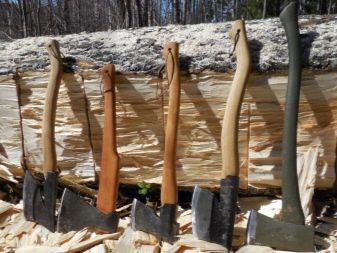

For chopping meat
Axes with a fairly wide and perfectly straight blade are most suitable for chopping meat. Usually, it is sharpened at an angle that prevents the cutting edge from breaking quickly with constant contact with hard, hard bones. The handle of this ax is usually short and extends down to the cutting edge, which is why the device allows very precise cutting blows.
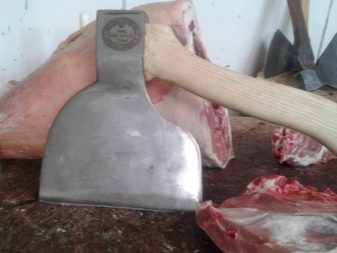
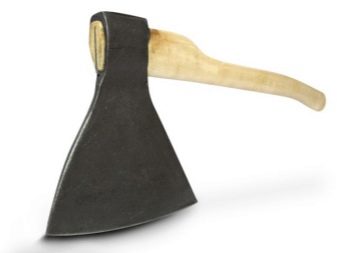
Bilateral
Double-sided axes have found their application in cutting wood blanks, preparing firewood and performing a variety of installation work. The working part of such tools has two blades, in most cases they are made of forged steel using the double heat treatment method. The handle is made of hardwood, most often from hazel.
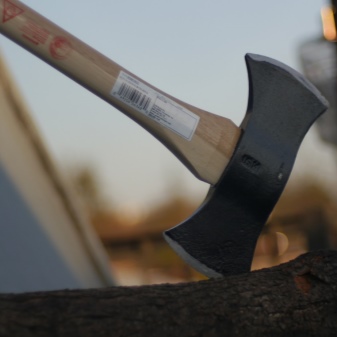
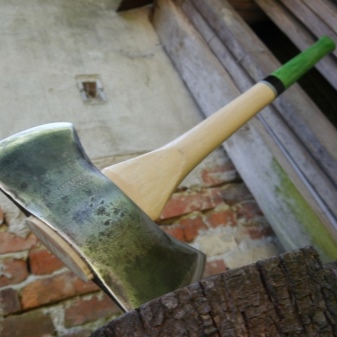
Fireman
Axes are widely used in the work of rescue services, in particular, firefighters use two types of axes - belt and assault. There is a rather sharp peg on the butt of the belt tool, which is necessary for knocking down locks and knocking out double-glazed windows.In addition, this hook can be driven into various surfaces to keep it in the wall or on the roof. Fire axes are usually painted black and red, although yellow inserts are often seen. The hatchet is covered with rubberized pads, which protect hands from burns. Unlike belt models, assault models are much larger in size, but their shape is very similar.

The butt often has a hook, or it can be flat, like a sledgehammer. This type of weapon is a mandatory component of any fire shield, which, according to safety standards, must be located in all public places.
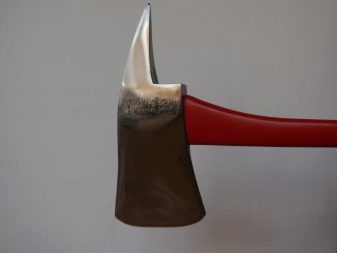
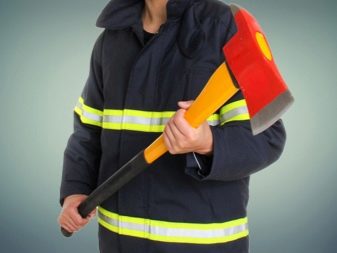
Marching
The tourist ax is called a multitool and has a wide variety of models. Their distinctive feature is their low weight, which is not surprising, given that the instrument has to be dragged on the back for many hours. The handle of such an ax usually becomes a pretty convenient storage for various small things that are needed on any hike. With the help of a tourist ax, different branches are cut, small trees are dumped and even stones are split to create a hearth. They are usually equipped with covers that protect a person from injury while carrying the instrument.
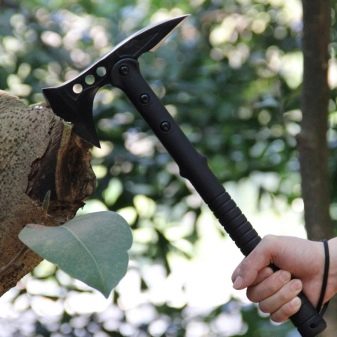
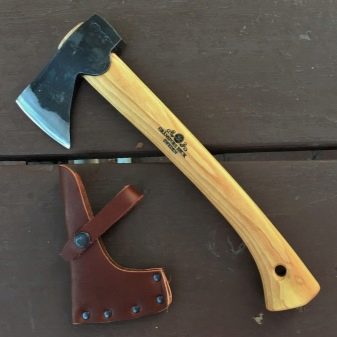
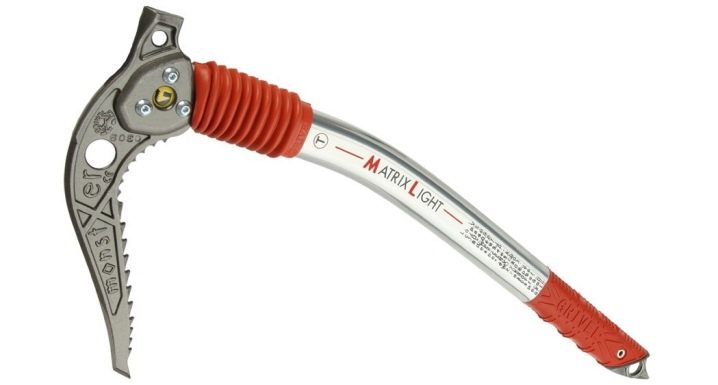
They are quite compact and lightweight devices that are necessary for cutting into the ice, if there is an ascent to the snow-capped peaks. This climbing equipment is made double-sided, with one part resembling a well-sharpened hook, and instead of a butt, a sharp blade is made, placed perpendicular to the handle - this structure is optimal for forming a depression in the ice. An army ax can also come in handy on a hike. It is widely used for preparing logs for a hearth, digging trenches, hammering tent pegs, and also as a defense weapon.
For information on how to choose the right ax, see the video below.
Different types of tools are used for different purposes, including the ax.
The ax has different purposes depending on the variety.
It will also have different parameters, sizes and shapes.
To choose the tool you need for a particular job, it is worth examining its types.
The main components are a hatchet and a metal part, which has a blade and a butt.
How to choose an ax?
For a long time in Russia, any man should have been able to own an ax; each owner had his own instrument, the handle of which was like an extension of the hand. Easy-to-use modern axes are made of quality materials
The choice of your tool should be approached carefully and pay attention to details.
Product weight plays an important role
When choosing Finnish axes and other professional models, you should pay attention to tools weighing from 2 to 2.5 kg. Lighter axes are inconvenient to use, while heavy ones put a strain on the hands.
The type of ax blade depends on the composition of the wood with which the master has to work.
The length of the handle is an important parameter on which the impact force depends when working with an ax.
Ax size
The parameters of the axes differ depending on their purpose and type. The shape of the blade, the length of the handle, and the weight of the tool vary. Standard axes for chopping firewood are considered large models, the length of the handle can vary from 70 to 100 cm, blade thickness - from 3 to 8 cm, weight - from 3.5 to 6 kg. Typical models of axes have other characteristics:
- handle length: from 40 to 65 cm;
- size of the sharp edge: from 10 to 17 cm;
- the size of the blunt part: from 4.5 to 7 cm;
- ax height: from 16.5 to 22 cm;
- the size of the sharpened part: from 1.4 to 2 cm;
- weight: from 0.7 to 1.6 kg.
Ax blade shape
In home tool stores, you can find axes with several types of butt - wide, which is used for logging, medium, considered universal, and narrow, designed for carpentry.The shape of the blade of a large ax can be different:
- Straight sharpening is necessary for tools with which they cut logs, chop wood.
- Shaving sharpening is suitable for axes that are used for curly cuts.
- Oval - ideal for meat axes used to chop bones, with this sharpening the blade does not get stuck in hard structures. This type of sharpening is good for small carpenter's axes.
Ax blade material
The question of which steel to choose an ax from is asked by all masters. Axes made of alloy steel are considered the most durable, followed by carbon blades in terms of properties. Alloyed alloys, widely used for the manufacture of axes, are currently inferior to modern materials. Fragile metals require frequent sharpening, such a tool will last less. When choosing a Scandinavian ax, experts advise to hit something metal with a blade and listen. A clear sound characterizes a quality product.
Ax handle
Axes with a handle made of wood have proven themselves best in work. Such instruments experience strong vibration, which is transmitted to the hands. A metal or plastic hatchet does not extinguish it, and it is more difficult to work with this type of tourist ax. The optimal balance of hardness and strength is demonstrated by birch. After several years of operation, the tree dries up. You can fight this by placing an ax in water, or by purchasing a model treated with paint or varnish. The advantages of non-wooden handles are undeniable, such axes:
- do not rot;
- do not crack;
- do not burn;
- fits comfortably in the hand;
- non-slip thanks to rubber pads.
Best Touring Ax
It is usually very light in weight and compact in size. The blade of such a hatchet can have semicircular edges to make it easier to carry in a backpack.
Most often, manufacturers pay special attention to the design of such a tool and be sure to supply it with a cover.
Main pluses:
- a light weight;
- complete set of the tool with a protective cover;
- a sharp blade that allows you to use the tool as a knife;
- handle length no more than 50 cm.

Minuses:
- high price (usually well above average);
- rust on the blade (after a long use, the blade becomes covered with a layer of rust, especially after a long stay in the case);
- not suitable for cutting firewood and logs.
Top Models:
- Geter Gator II. It will easily win the price-performance category, has a low cost, compact size and a comfortable fiberglass handle. Geter Gator II meets all the requirements for travel tools.
- Expedition HB-040. It can rightfully be called the most functional among all its fellows. The manufacturer supplied it with a straight blade and a bright handle to make it easier to find the tool in the forest.
Light weight, just over a kilogram, will not weigh down a tourist backpack, and a plastic handle with a rubber pad will make the ax as safe as possible when chopping branches.
STAYER Taiga. The lightest of the touring models. It has a rounded blade and a weight of 800 grams. It has a wooden handle, which is inconvenient during long hiking trips.
Ax blade
The quality of the ax blade is important, as bad steel will quickly cram and dull. Checking the material is very simple - click your finger or a hard object on the blade. A dull, quickly fading ringing is a clear sign of a poor-quality instrument. A sonorous, resonant sound will speak of good carbon steel. To improve performance, the blade is double hardened, forged and ground. The cutting edge of advanced axes has a special coating - it allows you to work longer with the tool without sharpening. A good ax is easily removed from the log when splitting, it is easy to sharpen.
Video how to choose an ax
When choosing an ax, first of all, you need to decide on the type of tool
A number of characteristics will depend on this, which should be paid attention to when buying.
Tool weight is important. A heavy ax will cut logs well, but it is impossible to work with it for a long time
Low weight, however, will require great human effort with little impact force.
The choice of the ax depends only on the personal preferences of the buyer. Plastic handles are just as durable as traditional wood handles. And the iron ax with a rubberized handle, despite its serious weight, is quite convenient to use.
Important parameters
When choosing a tool, you should pay special attention to the following points:
- Blade shape. It can be rounded and straight. The rounded shape allows for emphasis on cutting performance. The second option is more suitable for wood splitting.
- Sharpening the blade. A sharpening angle of less than 40 degrees allows the ax to penetrate deeper into the material. These tools are ideal for cutting trees, but will dull very quickly.
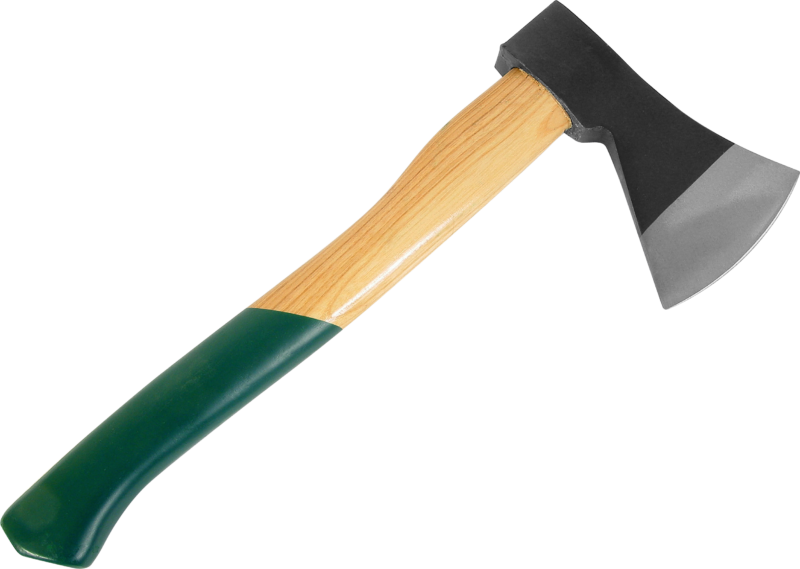
Many people prefer a combination sharpening, where the edges are more blunt compared to the center of the blade.
This greatly increases the strength of the tool, especially in cases where the impact force is transferred to the edge of the blade.
- Steel quality. First of all, it affects the durability of the tool. The branded head necessarily has a stamp indicating the grade of the tool steel. Preference should always be given to a forged product.
- The length of the ax. The short handle forces you to do the work with outstretched arms to increase the strength of the swing. In this case, giving back to the hand will interfere with long and productive work.
The ideal ax is to match the length of the arm from the shoulder joint to the wrist. It is very easy and comfortable to work with such a tool.
The thickness of the handle. The ax should fit comfortably in the hand. If the fingers do not close around him, then you can definitely prepare for injuries while working.
- Place of purchase. Often, tools in large hardware stores are more expensive than in the markets. Although this does not affect the quality in any way. The difference in prices for tools from the same manufacturer can be 15-20%.
- Instrument price. If the owner of the ax plans to use it almost daily, then you should think about buying a good and expensive tool that will quickly pay for itself.
But if you intend to use it from time to time, then buying an expensive model is impractical.
A tool with history: up to our times
The ancient stone ax was very heavy, uncomfortable and fragile. Of course, our ancestors could not do without him, because they had to build a house, and cut down a hunting club, and kill a mammoth, and then butcher, and drive a predator away from their prey. Such a tool often broke and was short-lived. They began to grind it only in the Neolithic period, then they began to make it from copper, and when iron was discovered, a brother of our modern instrument appeared - an iron one with a handle made of wood.
The main part of this tool was an iron chopper set on a sturdy hewn stick. But gradually the axes were divided according to their purpose, and the heavier models with a sharply sharpened ax turned into a military weapon, which, due to its cheapness and excellent chopping power, became the main weapon of the militia. For some time, such axes were the main type of hand-held edged weapons, but today they are no longer used in this capacity.
